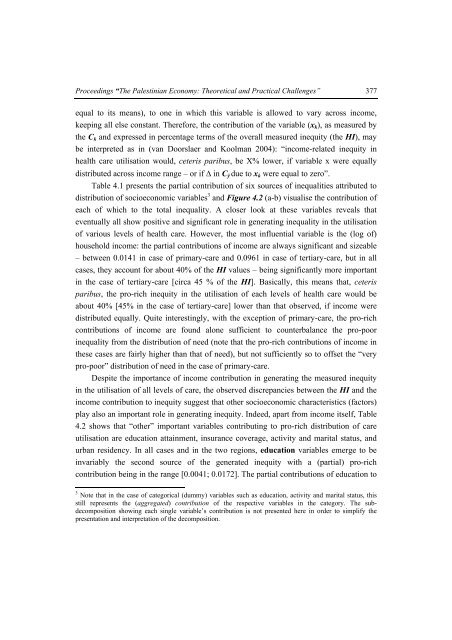The Palestinian Economy. Theoretical and Practical Challenges
The Palestinian Economy. Theoretical and Practical Challenges
The Palestinian Economy. Theoretical and Practical Challenges
Create successful ePaper yourself
Turn your PDF publications into a flip-book with our unique Google optimized e-Paper software.
Proceedings “<strong>The</strong> <strong>Palestinian</strong> <strong>Economy</strong>: <strong>The</strong>oretical <strong>and</strong> <strong>Practical</strong> <strong>Challenges</strong>” 377<br />
equal to its means), to one in which this variable is allowed to vary across income,<br />
keeping all else constant. <strong>The</strong>refore, the contribution of the variable (x k ), as measured by<br />
the C k <strong>and</strong> expressed in percentage terms of the overall measured inequity (the HI), may<br />
be interpreted as in (van Doorslaer <strong>and</strong> Koolman 2004): “income-related inequity in<br />
health care utilisation would, ceteris paribus, be X% lower, if variable x were equally<br />
distributed across income range – or if in C ŷ due to x k were equal to zero”.<br />
Table 4.1 presents the partial contribution of six sources of inequalities attributed to<br />
distribution of socioeconomic variables 3 <strong>and</strong> Figure 4.2 (a-b) visualise the contribution of<br />
each of which to the total inequality. A closer look at these variables reveals that<br />
eventually all show positive <strong>and</strong> significant role in generating inequality in the utilisation<br />
of various levels of health care. However, the most influential variable is the (log of)<br />
household income: the partial contributions of income are always significant <strong>and</strong> sizeable<br />
– between 0.0141 in case of primary-care <strong>and</strong> 0.0961 in case of tertiary-care, but in all<br />
cases, they account for about 40% of the HI values – being significantly more important<br />
in the case of tertiary-care [circa 45 % of the HI]. Basically, this means that, ceteris<br />
paribus, the pro-rich inequity in the utilisation of each levels of health care would be<br />
about 40% [45% in the case of tertiary-care] lower than that observed, if income were<br />
distributed equally. Quite interestingly, with the exception of primary-care, the pro-rich<br />
contributions of income are found alone sufficient to counterbalance the pro-poor<br />
inequality from the distribution of need (note that the pro-rich contributions of income in<br />
these cases are fairly higher than that of need), but not sufficiently so to offset the “very<br />
pro-poor” distribution of need in the case of primary-care.<br />
Despite the importance of income contribution in generating the measured inequity<br />
in the utilisation of all levels of care, the observed discrepancies between the HI <strong>and</strong> the<br />
income contribution to inequity suggest that other socioeconomic characteristics (factors)<br />
play also an important role in generating inequity. Indeed, apart from income itself, Table<br />
4.2 shows that “other” important variables contributing to pro-rich distribution of care<br />
utilisation are education attainment, insurance coverage, activity <strong>and</strong> marital status, <strong>and</strong><br />
urban residency. In all cases <strong>and</strong> in the two regions, education variables emerge to be<br />
invariably the second source of the generated inequity with a (partial) pro-rich<br />
contribution being in the range [0.0041; 0.0172]. <strong>The</strong> partial contributions of education to<br />
3 Note that in the case of categorical (dummy) variables such as education, activity <strong>and</strong> marital status, this<br />
still represents the (aggregated) contribution of the respective variables in the category. <strong>The</strong> subdecomposition<br />
showing each single variable’s contribution is not presented here in order to simplify the<br />
presentation <strong>and</strong> interpretation of the decomposition.
















